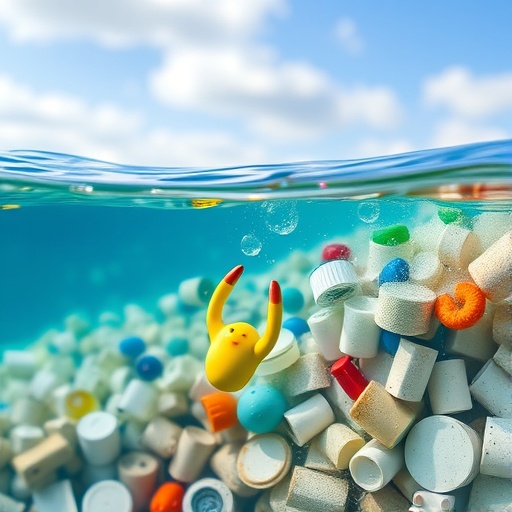In recent years, the scientific community has witnessed an exponential growth in the study of microplastics, microscopic fragments of plastic debris that permeate ecosystems globally. However, despite mounting evidence of their ubiquity and potential environmental risk, researchers face a critical challenge that threatens the reliability and comparability of their findings: the absence of standardized positive controls composed of representative materials. A groundbreaking study by McIlwraith et al., published in Microplastics and Nanoplastics, underscores the urgent necessity for such controls to elevate the rigor and reproducibility of microplastics research.
The crux of the problem lies in the highly heterogeneous nature of microplastic particles. These particles vary greatly in polymer type, size, shape, and chemical weathering status, factors that considerably influence detection, quantification, and toxicological assessments. Without positive controls that faithfully mimic this diversity, current methodologies often suffer from discrepancies between laboratories. This paucity of standardized materials impedes the harmonization of experimental protocols, rendering cross-study comparisons tenuous at best.
McIlwraith and colleagues present a compelling argument advocating for the design and deployment of positive control materials that encapsulate the physicochemical complexity of environmental microplastics. They propose creating reference materials that not only encompass a spectrum of polymer types such as polyethylene (PE), polypropylene (PP), and polystyrene (PS), but also include varied morphologies ranging from fragments to fibers. By incorporating such representative samples in analytical workflows, researchers can critically evaluate method sensitivity, specificity, and recovery efficiency.
A pivotal aspect of their discourse centers on the impact of polymer weathering and aging processes, which profoundly alter microplastic surface properties and environmental behavior. The study highlights that positive controls engineered to mirror these aged characteristics enable more accurate simulation of real-world detection scenarios. This approach addresses the pervasive issue of method calibration, as pristine laboratory-synthesized particles often fail to capture the complexity of environmental plastics.
The importance of validated positive controls extends beyond analytical chemistry into ecotoxicology, where understanding microplastics’ biological interactions hinges on exposure to realistic particle forms. Employing representative positive controls can thus refine dose-response models, facilitating better risk assessments. McIlwraith et al. emphasize that ecological relevance is paramount to ensure that experimental findings translate effectively into environmental policy and mitigation strategies.
Moreover, the study recognizes the critical role of international collaborations and standard-setting bodies, such as the International Organization for Standardization (ISO) and the Joint Research Centre (JRC) of the European Commission, in developing and disseminating these positive controls. Such cooperative efforts are poised to foster consensus and widespread adoption, ultimately propelling the microplastics field towards methodological consistency.
The practical challenges of fabricating universal positive controls are non-trivial. The authors discuss intricacies such as production scalability, long-term stability, and storage conditions, which must be meticulously addressed to maintain control material integrity. Furthermore, they underscore the need for open-access repositories, enabling researchers globally to obtain and utilize these standards without prohibitive costs.
An intriguing dimension of the study delves into analytical techniques employed in microplastics research, including Fourier-transform infrared spectroscopy (FTIR), Raman spectroscopy, pyrolysis-gas chromatography-mass spectrometry (py-GC-MS), and thermal extraction desorption gas chromatography-mass spectrometry (TED-GC-MS). The deployment of representative positive controls enhances the calibration of these instruments, fostering improved detection limits and classification accuracy across varied matrices like water, sediment, and biota.
McIlwraith et al. also tackle quality assurance and quality control (QA/QC) frameworks, emphasizing how positive controls form an integral backbone in verifying analytical reproducibility. Incorporating these standards into routine workflows minimizes false positives and negatives, which have historically plagued the field due to sample contamination and methodological biases.
The study’s implications resonate beyond environmental sciences, touching on public health domains concerned with human exposure to microplastics via ingestion and inhalation. More reliable data underpinned by representative positive controls will offer clearer insights into exposure pathways, aiding in the development of regulatory guidelines to curb potential health risks.
Crucially, the authors advocate for the development of layered control systems, encompassing negative controls (blanks), method blanks, and multiple positive controls with escalating complexity. This stratified approach would provide comprehensive performance benchmarking, enabling researchers to identify and troubleshoot analytical pitfalls holistically.
As microplastics research burgeons in scale and scope, McIlwraith et al. warn against complacency in methodological practices. They contend that without the foundational support of robust positive controls, scientific conclusions risk being marred by inconsistency and skepticism. Their research thereby serves as a clarion call, urging the community to prioritize standardization efforts urgently.
Looking forward, the integration of advanced materials science and nanotechnology offers promising avenues to fabricate synthetic control particles with finely tunable properties. These innovations could further mirror environmental microplastics’ heterogeneity, fostering next-generation reference materials that enhance methodological precision.
In summation, the work of McIlwraith and colleagues marks a pivotal turning point for microplastics investigations. By championing the indispensable role of positive controls that feature representative materials, they lay the groundwork for more rigorous, transparent, and comparable research practices. As this field confronts escalating environmental and health challenges posed by plastic pollution, their insights provide a vital roadmap to strengthen scientific foundations and catalyze impactful solutions.
Subject of Research: Standardization and development of positive control materials for microplastics research.
Article Title: Positive controls with representative materials are essential for the advancement of microplastics research.
Article References:
McIlwraith, H.K., Lindeque, P.K., Tolhurst, T.J. et al. Positive controls with representative materials are essential for the advancement of microplastics research. Micropl.& Nanopl. 5, 9 (2025). https://doi.org/10.1186/s43591-025-00115-y
Image Credits: AI Generated
DOI: https://doi.org/10.1186/s43591-025-00115-y
Tags: challenges in microplastics detectioncross-study comparison issuesenvironmental impact of microplasticsheterogeneity of microplastic particlesmicroplastics and ecosystem healthpolymer diversity in microplasticspositive controls in microplastics researchreference materials for microplasticsreproducibility in scientific findingsrigorous methodologies in researchstandardization in environmental studiestoxicological assessments of microplastics





